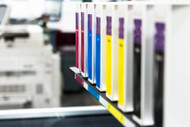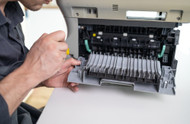Ink Cartridge Recycling: Environmental Benefits and Methods
In our fast-paced digital age, where the demand for printers and printing services is on the rise, the environmental impact of discarded ink cartridges cannot be ignored. As a responsible consumer, taking steps towards ink cartridge recycling can contribute significantly to reducing the environmental footprint associated with this ubiquitous office accessory.
- Summary
- Environmental Benefits of Ink Cartridge Recycling
- Methods of Ink Cartridge Recycling
- Conclusion
Environmental Benefits of Ink Cartridge Recycling
1. Conservation of Resources:
Ink cartridges are predominantly made from plastic, a material derived from non-renewable resources. By engaging in recycling programs, individuals can contribute to resource conservation. This process involves collecting used cartridges, preventing the need for new plastic production and reducing the strain on our planet's finite resources.
2. Reduction of Landfill Waste:
Each year, millions of empty ink cartridges find their way to landfills, contributing to the growing problem of electronic waste. These cartridges are composed of materials that can take hundreds of years to decompose. By actively participating in ink cartridge recycling, we can divert these items from landfills and mitigate the negative impact on our environment.
3. Energy Savings:
The production of a new ink cartridge requires significant energy inputs. By recycling used cartridges, we can reduce the energy demand associated with manufacturing new ones. This, in turn, helps lower carbon emissions and supports a more sustainable approach to the life cycle of printer consumables.
Methods of Ink Cartridge Recycling
1. Manufacturer Programs:
Many ink cartridge manufacturers offer recycling programs to encourage responsible disposal of their products. These programs typically involve the collection and return of used cartridges to designated drop-off locations. Some manufacturers even provide incentives, such as discounts on future purchases, to incentivize consumers to participate in these initiatives.
2. Retailer Take-Back Programs:
Several major retailers also have take-back programs for used ink cartridges. These programs are often accessible in-store, allowing consumers to drop off their used cartridges during their regular shopping trips. By teaming up with retailers, ink cartridge manufacturers can increase the convenience of recycling for consumers.

3. Local Recycling Centers:
In addition to manufacturer and retailer programs, many municipalities have established local recycling centers that accept electronic waste, including ink cartridges. These centers may provide dedicated bins for cartridge collection, making it easy for residents to dispose of their used cartridges responsibly.
4. Mail-In Recycling Programs:
For those unable to access physical drop-off locations, some companies offer mail-in recycling programs. Users can request prepaid shipping labels to send their used cartridges directly to recycling facilities. This option extends the reach of recycling initiatives to individuals in remote areas or with limited access to traditional recycling options.
As environmental awareness continues to grow, the importance of ink cartridge recycling becomes increasingly evident. In the words of environmental advocate Jane Doe,
"Recycling ink cartridges is not just about disposing of electronic waste responsibly; it's a tangible step towards a more sustainable future. Each recycled cartridge is a small contribution to the greater cause of preserving our planet for future generations."
Conclusion:
The environmental impact of ink cartridges is a pressing concern that cannot be overlooked. Engaging in ink cartridge recycling is a practical and impactful way for individuals and businesses alike to address this issue. By conserving resources, reducing landfill waste, and saving energy, recycling contributes to a more sustainable approach to printer consumables.
As consumers, we hold the power to make environmentally conscious choices. Whether through manufacturer programs, retailer take-back initiatives, local recycling centers, or mail-in options, there are various avenues available for us to play our part in the global effort to reduce electronic waste. Let's embrace the responsibility to recycle ink cartridges, taking small yet significant steps towards a greener and more sustainable future.





